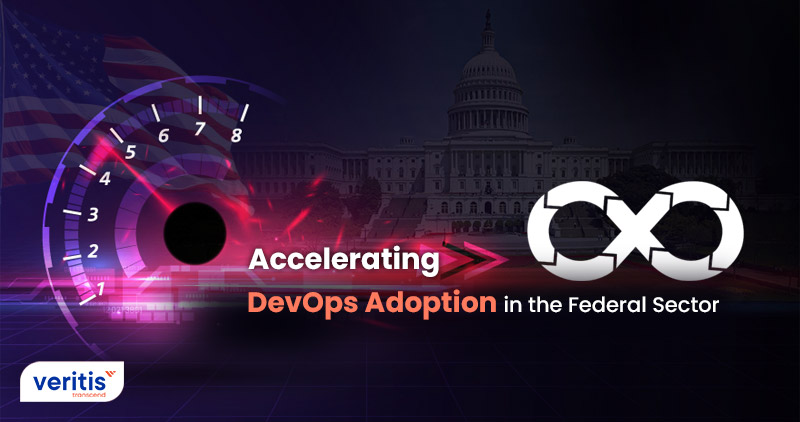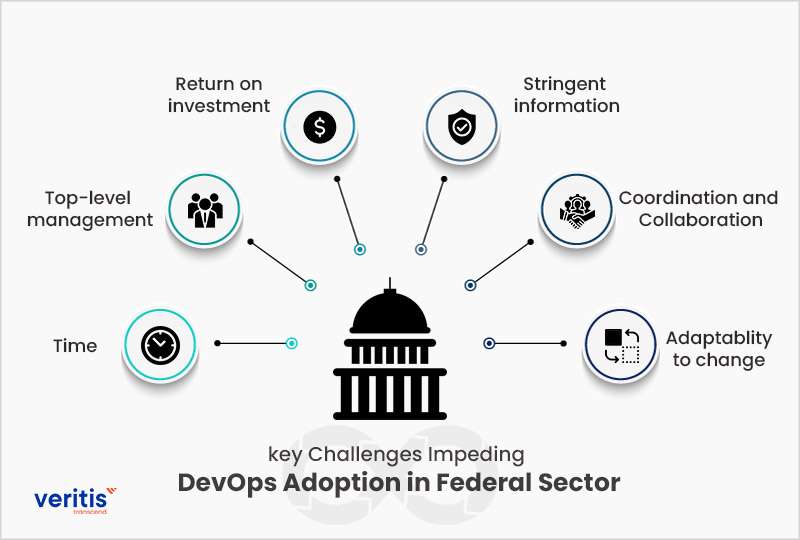
Days are gone when the IT transformation and run for technology inclusion were limited to the private sector. Now, governments across the world are in the game! Changing public mindset, growing demand for quicker delivery of services, and dire need to maintain an upper hand over the private players have led the public-sector organizations to go digital and tech-savvy.
The private sector is implementing cloud technologies at a rapid pace to modernize its systems and satisfy client expectations. In contrast, the public sector is still lagging. Government organizations and agencies must undergo the same digital transformation as the private sector. Additional security concerns regarding sensitive data may slow cloud adoption.
DevOps methodologies have gained popularity among many government organizations, including the US Air Force, to speed up and enhance the delivery of applications and services. For a while, as we observed production support to transform into this integrated approach to development and delivery, many of our contemporaries and we anticipated the dawn of the DevOps era.
However, for the government to successfully adopt DevOps and more agile IT approaches, agencies will need to tear down the cultural barriers stagnating our government’s approach to IT. In addition, the government will need to reconsider its procurement, DevOps security, and compliance policies and streamline the end-to-end life cycle processes through automation.
Besides, the growing public demand for the personal and professional environment has also moved world governments to quest for the right technology deployment to offer safe, secure, and quality public services. But, unfortunately, the trend of digital applications in the government sector appeared out of this need!
Eventually, many US federal departments and agencies have already begun adopting agile workflows with collaborative techniques to ease their internal functioning, and DevOps team appeared as a solution for many!
What is DevOps?
Although there are many definitions, DevOps is fundamentally a software development philosophy that uses the agile paradigm and necessitates re-engineering business processes and a significant cultural shift.
For DevOps team to work, breaking down organizational silos is crucial. When people cannot communicate, they cannot collaborate on software. IT leaders must support the plan and be willing to switch from the high-risk, low-reward waterfall development model to the low-risk, continuously iterative DevOps model, which offers high rewards in the form of working software.
Commercial technology firms like Google, Amazon, Netflix, and Facebook have mastered DevOps, resulting in the internal release of thousands of daily software upgrades. However, the method is relatively new to federal agencies and presents some challenges.
Now, let’s take a look at the DevOps adoption trend in the US government sector and how it helps gain a technological edge:
DevOps Adoption Trend in the Federal Government
A survey by a renowned IT firm found some alarming results about the DevOps framework adoption trend among public-sector employees.
While 79% of respondents in US Financial Services have adopted DevOps culture in some form, and 75% of IT and Tech respondents, it is only 59% in the public sector. Only 11% of respondents had no plans to adopt DevOps within two years, compared to 20% of those in the US Government sector.
DevOps workflows are very impressive to modern businesses because of their agility. Like how they expect technology-first companies to deliver their services, the public does the same with government programs and services. You can anticipate higher processing accuracy if your agency correctly implements DevOps team processes without sacrificing compliance with the relevant regulatory frameworks.
Public sector organizations face challenges that don’t always affect private businesses similarly. One of the main risks is funding new initiatives and ensuring process changes don’t expose agencies to data security vulnerabilities.
However, these issues can quickly solve thanks to the flexibility and enhanced oversight of the DevOps Lifecycle.
It’s crucial to emphasize to department heads that DevOps is a culture that creates Continuous Integration and Continuous Delivery (CI/CD) pipelines when speaking with them.
Useful Link: 3 Factors That Decide Organizational Readiness to DevOps Adoption
Why DevOps in Government Services?
Government departments have been following traditional linear requirements wherein developers write code for the service requirement and pass it on to the operations team for deployment.
Unfortunately, in the process, none of the two teams were aware of each other’s ways of using the service and the resultant impact in real-time, which could be a violation of regulation, security, and more, causing the disruption.
The operations team can have a look back to developers in case of a concern, but that turns out to be critical if the concern is significant and takes time to get fixed, which might consume the recovery time and hurt the workflow for the following projects.
This gap between the two teams might be familiar even in the private sector. Still, government departments are, in fact, more vulnerable to this scenario as they directly deal with laws, regulations, and matters of public concern. So, the US Federal Government must adopt the DevOps methodology.
Security, A Prime Obstacle for DevOps Adoption
The ultimate need for creating safe, secure, innovative and qualitative digital solutions to ensure faster service delivery made government agencies plan DevOps adoption. However, privacy and security posed challenges for some government departments in adopting DevOps solutions.
So, maintaining transparency of sensitive information as part of collaborative development is a real matter of concern!
Here are the ways to overcome the security challenges in DevOps implementation:
- The solution could be the creation of an integrated toolchain. An integrated toolchain and a graphical mapping of the requirements associated with the data to be tested could solve the above problem. Through this, the teams can visually map the test scenarios and proceed accordingly to create, automate, and optimize test cases. Thus, they can provide either masked production data or simulated data for testing, thus hiding actual sensitive information.
- Another critical part is the simulation of the application being worked on, which allows the development and test teams to integrate and run performance tests against the virtual environment.
- The next level of quicker and quality delivery that the DevOps tools environment allows is automation. Automation integration across the toolchain removes the process from heavy and lengthy scripts minimizing the chances of exposing sensitive data.
The usage of synthetic or masked data facilitates collaboration among Dev and Ops teams to work on life-like data without compromising sensitive information. And such methods supported by effective DevOps practices can address the government sector’s primary concern of dealing with security and transparency in DevOps implementation.
Useful Link: Database Development – The Secret Behind the Rising ‘DevOps Adoption’
Other Critical Challenges That the Government Sector Faces in Implementing DevOps Include the Following:

- Approval times associated with the operation
- Top-level management support
- Less dependency on Return on Investment (ROI)
- Stringent information security policies
- Internal coordination and collaboration
- Adaptability to change
DevOps Strikes the Balance Between Speed and Quality
There might be a misconception that quicker delivery of services would sometimes compromise quality. That’s not the case with DevOps principles. Here, two teams that are key to the final product work collaboratively with a clear understanding of each other’s workflows unlike in the traditional approach where a single change threatens the entire project.
While maintaining faster deliveries, DevOps also ensures quality by allowing solutions like automation, thus reducing manual errors by automating core deployment and development functions.
This is another major factor that comes as a value-addition in the form of DevOps for many government agencies in producing better end-products as part of their public services.
Digital Governance, A Growing Trend in the US Federal Sector
Digital transformation has changed the way industries operate and further instigated government agencies also to look into technology deployment for offering their public services in a better way.
Flexibility, cost-savings, collaboration, and the need to minimize manual processes to save time have influenced governments worldwide, especially in developed countries.
Eventually, few governments begun deploying new DevOps technologies, even in the developing world, and more are in the offing.
A recent Insight session organized by the OpenGov-Asia, an initiative promoting ICT transformation in the Asia-Pacific public sector, saw senior technology leaders from government agencies pitching for advanced technology inclusion for better governance.
As part of the discussions, a strong pitch was made for the deployment of the trending technology services such as Big Data Analytics, Internet of Things (IoT), AI, and DevOps as a means to achieve effective governance across various areas such as healthcare, defense, transportation, financial services, innovative city development, and civic management.
Deployment of DevOps practices was listed among keyways such as data-driven culture, agile and lean methods for successful use of data to address key business challenges.
Useful Link: 10 Priorities Around Container Adoption in DevOps Lifecycle
Eligibility to DevOps Adoption

A Federal agency’s eligibility or ability to adopt DevOps can be assessed by following factors:
- Inclusion of members from multiple disciplines across technical teams
- Developers access to production-equivalent development environments
- Facility to move applications between environments with changes to their environment variables
- Application’s ability to work on a self-service basis
- Availability of Platform-as-Service (PaaS) services
- Quick turn-around time right from request submission to delivery of all components
Overall, DevOps can be a good solution for many government agencies that are striving to serve public with more fast and effective services powered by new-age digital tools and advanced technologies, provided the aforementioned requirements are met.
Key Takeaways:
- The US Federal Government sector continues to lag in its DevOps adoption, but the understanding and appreciation of the benefits it can bring are now widely recognized.
- The challenge for IT teams in the sector is to overcome the DevOps security challenges to maintain the upwards trend of adoption.
- Partnering with DevOps Services Providers like Veritis can help complete the adoption journey.
Advantages of Using a DevOps Approach
1) Improved Client Experience
By assisting businesses in increasing deployment frequency by 200 times, decreasing downtime by 24 times, and reducing change failure rates by three times, DevOps strategy can significantly improve customer experience. Furthermore, businesses can leverage DevOps to automate their entire delivery pipeline, ensuring the reliability and stability of applications after each new release. This eliminates labor-intensive, inefficient, and error-prone manual processes. Any application that runs without a hitch enables businesses to provide a great customer experience, boosting sales and profits.
2) Faster Deployment
Through its automation principles, continuous delivery, and quick feedback, the DevOps adoption approach can assist organizations in driving a quicker and more effective software development process. As a result, organizations can quickly implement new processes, systems, and applications, accelerating deployment. In addition, organizations can achieve their goals thanks to DevOps because when staff members collaborate, development and deployment tasks take less time to complete.
3) Rapid Collaboration
DevOps also fosters a fast-paced, continuous feedback culture, ensuring prompt resolution of all technical issues. DevOps fosters cross-team cooperation, communication, and integration among geographically dispersed teams, significantly increasing business agility. It enables various teams, like development and operations, to comprehend one another’s workflow. The team is accountable for the deliverables’ quality and timeliness.
4) Less Time Between Software Releases
A DevOps adoption strategy can significantly help organizations promote quicker software release cycles. As progress is incremental and less disruptive to system stability, shorter software release cycles assist organizations in managing planning and risk while enabling them to respond better to changing customer needs.
5) The Concept of Silos is Outdated
Development teams must overcome their inter-departmental silos due to the shifting market dynamics. DevOps will ensure that the siloed approach of the past is history because it encourages increased interaction between teams of developers and operations personnel, significantly increasing team transparency.
DevOps can get past the usual IT barriers and drive the newer, more organized processes while eradicating the older, linear ones. Working in silos has generally been observed to lead to a lot of resentment and misunderstanding among various teams with little transparency on either side. Such issues are addressed by DevOps, which also streamlines the execution of projects using an agile methodology.
Conclusion
Though the ultimate objective of DevOps is to integrate Dev and Ops seamlessly, it’s easier said than done. As a result, many organizations, including private and public agencies, struggle to complete the entire adoption journey – from a single application to the enterprise level.
Challenges and complexities vary at every stage, bogging down even the most promising efforts to scale the products and services through the entire scope of DevOps adoption. The bottom line: you need a holistic approach to realize DevOps success. This is where the services of Veritis prove indispensable.
Veritis, Stevie Award winner for DevOps services, is catering to the technology needs of clients across all sectors. Whether you are a federal agency or a private enterprise, we have DevOps solutions customized to your specific business requirements.
Our DevOps experts help you build a comprehensive strategy that guides your business through DevOps adoption and transformation from application to enterprise. Contact us, and let us help you imbibe the new collaborative approach across your business processes.
Got Questions? Schedule A Call
Additional Resources:
- DevOps Adoption and Transformation: Approach, Best Practices and Business Benefits!
- DevOps Adoption, Strategy and Market Trends
- DevOps Adoption in Financial Services Industry – A Catchy Trend!
- 8 DevOps Adoption Challenges Businesses Must Overcome
- Looking for DevOps Services partner in Texas?
devops services